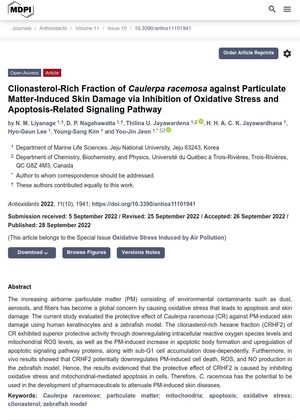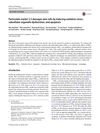Clionasterol-Rich Fraction of Caulerpa Racemosa Against Particulate Matter-Induced Skin Damage Via Inhibition of Oxidative Stress and Apoptosis-Related Signaling Pathway
September 2022
in “
Antioxidants
”

TLDR A substance from Caulerpa racemosa seaweed may protect against skin damage caused by air pollution by reducing oxidative stress and cell death.
The document presents a study on the protective effects of a clionasterol-rich fraction (CRHF2) from the seaweed Caulerpa racemosa against skin damage induced by particulate matter (PM). The study involved tests on human skin cells (HaCaT keratinocytes) and zebrafish embryos. The results showed that CRHF2 increased cell viability, reduced reactive oxygen species (ROS) production, decreased the number of apoptotic bodies, and reduced the expression of apoptosis-related proteins. In zebrafish, CRHF2 was found to protect against PM-induced damage. The study concludes that CRHF2 could potentially be used in pharmaceuticals to mitigate PM-induced skin diseases due to its antioxidant and antiapoptotic activities. The experiments were triplicated (n = 3) to confirm their repeatability.

